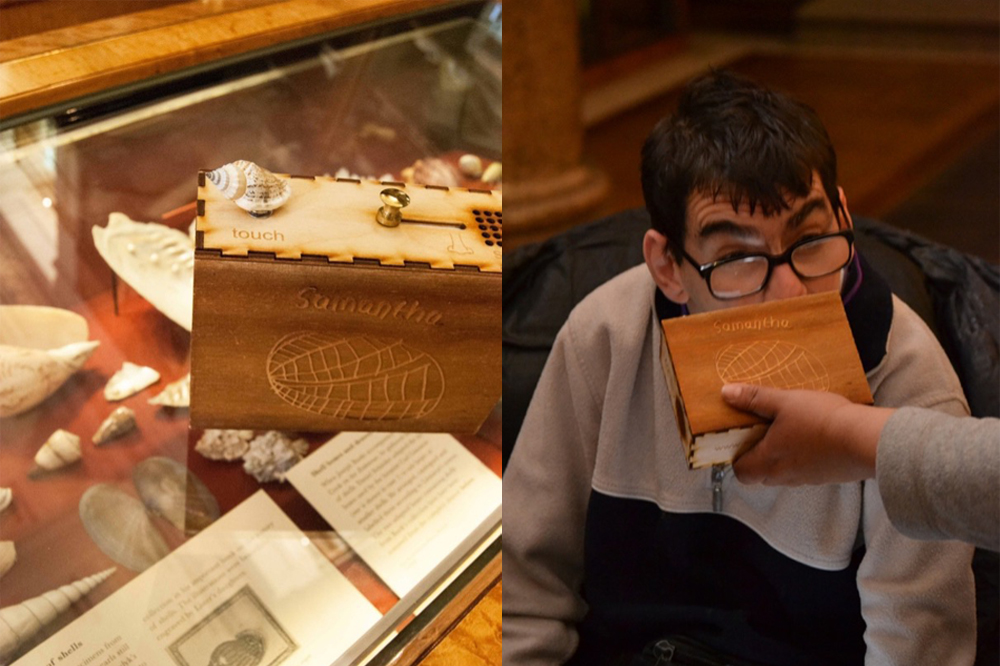The Sensational Museum has invited purpleSTARS to be partners in a research project radically re-thinking the role of the senses in museums.
This £1M project funded by the Arts and Humanities Research Council (AHRC), is an interdisciplinary project aiming to design and create sensory interventions that are accessible to all, using what we know about disability to change how museums work for everyone.
The Sensational Museum interdisciplinary researchers were keen to find out more about the purpleSTARS sensory approach to support inclusive research and to learn about the RIX Inclusive Research award winning Sensory Objects research project (2012-2015, funded by AHRC) that led to the creation of purpleSTARS.
Kate Allen, purpleSTARS member, was invited to take part in The Sensational Museum project retreat in Cardiff. This was a valuable experience where all participants were given the opportunity of time and space to meet up, share, reflect and discuss ideas.The Sensational Museum is rethinking the role and place of the senses in museums. The project questions and rejects two common assumptions about the senses.
- There are only five bodily senses
- Sight is the most important sense of all
We discussed other types of bodily senses, for example the sense of proprioception, our body’s ability to sense movement, action, and location. Working with Virtual Reality (VR), purpleSTARS have explored the importance of an embodied sensory experience by creating an interactive exhibit for The Museum of English Rural Life (MERL). Our experiments led to the purchase of a quad bike for an interactive VR experience of being a shepherd driving the quad bike to herd sheep on Dartmoor. Sitting astride the quad bike or holding the vibrating handlebars of the wheelchair user’s version, added important sensory information and a layer of understanding, experience and fun for the exhibit at the MERL.
The Sensational Museum researchers introduced the notion of Sensory Gain, the idea that everyone can benefit from the ‘access’ traditionally offered only to disabled visitors. This is a great way to highlight the importance, relevance and richness of alternative approaches to museum collections, and to value diverse perspectives through inclusive research and universal design.
The Sensory Objects project provoked people to consider the importance of valuing diverse and sensory understandings of museum objects. Dr Natasha Barrett who, at the time in 2016, was a Museum Studies PhD student from the University of Leicester (AHRC Midlands 3 Cities funded) discussed the impact of the Sensory Objects project on her research. She studied colonial-era photographs (1860s-1914) of Māori, the indigenous Polynesian people of New Zealand. She was exploring how these photographs have been understood and used over time by both Māori and non-Māori, within and outside of British museums. Her thesis considered these photographs as three-dimensional physical objects, that could reflect social connections amongst communities and with institutions around the world holding photographic collections.
A few months ago, as part of my PhD fieldwork, I met up with Dr Kate Allen at the British Museum. Despite our projects seeming quite dissimilar, there were many parallels, which were helpful for my research. For example, groups of people (and individuals) understand the world in very different ways and all are equally valid. The challenge for those of us working in museums is to try and understand this. We then need to create space for alternative ways of explaining objects. Sensory Labels fully and cleverly achieves this.
Dr Natasha Barrett

A sensory interpretative journey by Natasha Barrett
Valuing the unique perspective of a person with the lived experience of learning difference or disability, was noted and discussed by Matthew Goodsell writing about The Aura of a Sensory Object.
For a person with learning difficulties, an object may have a value or significance others cannot fathom. The person cannot say why the object is significant, and this causes a difference in perception we might call a type of aura. The person to whom the object is significant may see the tree yet can only tell others of the shadow. It is through these objects, whose significance may be hidden from us, that we are left to reconstruct the discourse of learning disability history. Inasmuch as it is, in part, shrouded from us because it cannot be articulated as it usually would be, it is an auric discourse. We who observe from without are distanced from it yet are fascinated to explore this mysterious terrain.

The Aura of a Sensory Object by Matthew Goodsell
The Sensational Museum research project has the potential be the catalyst for a significant change of mindset towards sensory museum curation, providing practical tools and new ways to archive and catalogue museum collections. This multi-partner project is not just a project about making museums accessible to disabled people, it is a project that uses what we know about disability to change how museums work for everyone.
Written by Kate Allen

